|
Jade Emperor
See
Yu Huang.

jae (แจ)
Thai. 'Fasting'. Term usually referring to the food eaten by the Chinese
during their Lent or time of fasting, traditionally vegetarian. Also
transcribed je.

Jagadambi
(जगत्अम्बा)
Pali-Sanskrit. 'Mother of the world'. Title given to Parvati, the
consort to Shiva. Also called Jagadamba and
in Sanskrit also
Jagamata.

Jagamata
Sanskrit. 'Mother of the world'. One of the kind forms of Devi, the
consort to Shiva. See also
Jagadambi.

Jagannath (जगत्नाथ)
Sanskrit. 'Lord of the world'. A name for Krishna. Also pronounced
Jagannatha.

Jahnavi
Sanskrit. 'Daughter of Jahnu', nickname for the river Ganges in India.

Jahnu
A
sage who, during his devotions, was once disturbed by the noise of the
Ganges river and therefore drank its waters. He later regretted this and
allowed the river to flow out from his ear. Thus, the Ganges got its
nickname Jahnavi, 'daughter of Jahnu'.

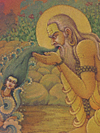
Jainism
Philosophical sect founded in North India by the venerated ascetic
Vardhamana who became known as Mahavir, the 'great hero'. The Jains
found their entire system of ethics on ahimsa, a doctrine based on the
non-harming of all living things. As in Hinduism a belief in karma is
adhered to, and like Buddhism it originated in opposition to the Brahman
principles of the sixth century BC, but never spread beyond India. The
two main sects are Digambara and Svetambara. See also Tirthankara.

jamajurih (จามจุรี)
Thai. Hair of a yak or a yak's tail, used in various forms as a symbol
of royalty or kingship, and as the attribute of several gods in
Buddhism, Hinduism and Taoism. Also jamarih and often pronounced
jamjurih.


jamarih (จามะรี)
See
jamajurih.

Jambhala
Name for wealth gods in Mahayana Buddhism. It is believed that they
dispense riches and that their number totals five to twelve, each with a
different objective. They bless others by eliminating poverty, so that
they may practice the dharma. In art they are sometimes depicted holding
a mongoose that spews out precious jewels. Some sources however,
describe Jambhala as being Vaisravana, or see him the equivalent to Kubera
or Kuvera in Hinduism, whilst others mention him as a wealth-giving form
of Avalokitesvara, the bodhisattva of compassion. He may at times also
be compared to Phra Sangkatjaai. Sometimes transcribed Dzambhala.

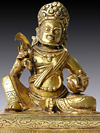
Jambupati
Indian mythological emperor who was too proud to listen to the words of
the Buddha. The Buddha then changed himself into a great and mighty
emperor and invited Jambupati to visit him. This event changed Jambupati
and he became perceptive to the teachings of the Buddha. This story
appears only in Southeast Asian literature on the Buddha's legendary
life.

Jamuna
Name of a river in North India, which is personified as a Hindu goddess
riding a tortoise.

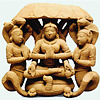
Janaka (जनक)
Father of Sita in the Indian epic Ramayana.

janghan (จังหัน)
Thai. The food or meal of a monk.

Jara
Sanskrit. 'Old age'. The huntsman who unwittingly killed Krishna.

jata (जटा)
Sanskrit. 'Matted hair'. Matted chignon or braids of entangled hair as
worn by Shiva, ascetics and rishis. It is a sign of either mourning or
of an indifference towards worldly matters. Sometimes translated as
dreadlocks. See also
jatamukuta.

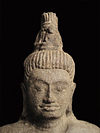
jataka (जातक)
Sanskrit and Pali word for the Thai term chadok. It is one of the in
total 550 incarnations that every soul has to take before one can be
born as a buddha. Generally it stands for the 547 life stories of the
Buddha, but in Burma three extra lives were added for reasons of
symmetry in mural paining. In Thai tradition the ten last incarnations
of the bodhisattva who became the Buddha, prior to his final birth as
prince Siddhartha, are the most important and are called Totsachat.

jatamukuta
(जटमुकुट)
Sanskrit. 'Crown of matted hair'. The matted and braided chignon of hair
worn by Shiva as an ascetic. Often depicted as an elaborate headdress
adorned with his cresent. The word derives from jata (matted hair) and
mukuta (crown). Sometimes spelled jatamukata.

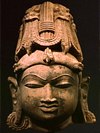
Jatukam (จตุคาม)
Thai. Derivative name of Tao Kadtukam, one of two guardian gods of the
holy relics of the Buddha. See also Jatukam-Ramathep.

Jatukam-Ramathep (จตุคาม-รามเทพ)
Thai. Name of a large, very popular amulet in the shape of a medallion,
about 6 millimeters thick and a diameter of around 5.4 centimeters. The
original Jatukam-Ramathep amulets were introduced in the 1980's by Khun
Phantharak Rajadej, a police chief from Nakhon Sri Thammarat, to raise
funds for the construction of a lak meuang (city pillar). The amulet was
then priced at 49 baht. The amulets became very popular when the Police
Major General died at the age of 103 (some say 108) on 5 September 2006,
just days before the coup d'état that ousted prime minister Thaksin
Shinawat, and now, many are sold for more than 100,000 baht each.
Believers wear the amulet around the neck as a talisman as it is
believed to have magical powers and protect its owners. The front side
of the amulet shows the god Tao Ramathep seated with the right knee
uplifted in a casual yoga position and surrounded by the animals of the
Chinese zodiac, a reference to the coat of arms of Nakhon Sri Thammarat,
and by eight figures of the demon-god Rahu. The back side shows a relief
with some ancient yan signs that have an animist protective purpose. Tao
Ramathep is, together with Tao Kadtukam (Kattukam), the guardian god of
the holy relics of the Buddha. Their statues stand at the doorway of Wat
Mahathat Wora Maha Wihaan in Nakhon Sri Thammarat. The name of Tao
Kadtukam was over time understood to be Jatukam, hence its present
designation. Buddhists today have become obsessed with this alleged
magic amulet, despite warnings that the circular icon is only a secular
crutch, corrupting both religion and society. Due to its magical claims
and a highly inflated resale value the amulet has caused an
out-of-control craze. Thieves have broken into shops and homes and
infiltrated temples to steal it. When in April 2007 a fresh batch of the
lucrative charm went on sale in southern Thailand, a crowd of thousands
waiting to buy erupted into a stampede, trampling a woman to death and
injuring many others. See also Tao Ramathep.

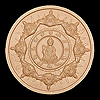
jatulohkabahn
(จตุโลกบาล)
1. Thai-Pali. 'Four keepers of the world'. The four guardians protecting
the world by presiding over the four points of the compass. In Sanskrit
they are called lokapalas and may vary in number. See also lokaban. 2.
Thai-Pali. 'Four keepers of the world'. The chief thevada in the fourth
grade heaven with four faces presiding over the four points of the
compass. Compare with Phra Phrom Sih Nah.

jaturaphak
(จตุรพักตร์)
Thai-Pali. 'Four-faced one'. A name of Brahma. See also Phra Phrom Sih
Nah.

jawed (เจว็ด)
Thai. An image of the household god put up in a spirit house called sahn
phra phum. Sometimes also called trawed or tawed.

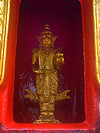
Jesus Christ
Name of the central figure of Christianity, who is revered by most
Christians as the Son and incarnation of God and part of the Trinity,
that is One Being, who exists as three Persons, to be precise God the
Father, God the Son and God the Holy Spirit. In other words, whilst
being fully Human, Jesus is also fully God, as well as Spirit, a concept
reminiscent to the avatars in Hinduism. The name Jesus derives from the
Greek Iesous (Ἰησοῦς), a Hellenisation of the Hebrew-Aramaic names
Yeshua (ישוע) and Yehoshua (יהושע), both meaning 'Yahweh rescues',
whereas Christ is a title that derives from the Greek word Christos (Χριστός),
meaning the 'Anointed One', which corresponds to the Hebrew-Aramaic word
Messiah (משיחא). He is also known as Jesus of Nazareth, after his
childhood home town. Judaism rejects the claim that Jesus is the Messiah
and incarnate God, and Islam regards Him as a prophet. The icon of
Christianity early on was a fish, usually referred to as the Ichtus
symbol, which besides its reference to Jesus' fisherman disciples, also
is a Greek acronym for Iesous Khristos Theou Huios Soter (Ἰησοῦς Χριστός
θεοῦ Υἱός Σωτήρ), meaning 'Jesus Christ, Son of God, Saviour'.

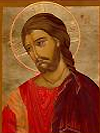
jiewon (จีวร)
The outer robe of a Buddhist priest, also called traijiewon. See also
pahkahsahwapad.

Ji Gong (济公)
Chinese. 'Honourable Ji' or 'Master Ji'. Name of a Buddhist monk who
lived from 1130 to 1207 AD in the region of Hangzhou. Although he had a
kindhearted and obliging character, he was expelled from his monastery
for braking the rules of the Vinaya, by eating meat and drinking wine.
However, many who observed his unconventional, yet kind and
compassionate nature, began to believe that he was an incarnation of
Xianglong, the Taming Dragon, one of the eighteen legendary luohan. He
is posthumously worshipped as a minor Taoist deity and is usually
depicted in monastic robes with a nahm tao calabash and a leaf-shaped
fan which is believed to be magical. Sometimes transcribed Chi Kong or
Chi Kung and also known by the names Ji Gong Huo Fo, 'Honourable Ji, the
Living Buddha'; Dao Ji Chan Shi, 'Taoist Ji, the Meditation Master' or
'Taoist Ji, the Zen Buddhist Master; Li Xiu Yuan, 'Li, the First
Decorated'; Hu Yin, 'Recluse of the Lake'; and Fang Yuan, 'Square
Circle'.


jihn sae (จีนแส)
Thai term for a Chinese sage.

jina
Sanskrit. 'Conqueror' or 'victorious one'. In Jainism called a Tirthanka.
In Buddhism the term indicates the historical Buddha or the five
transcendental buddha's of the Mahayana sect, in which each jina is
assigned to a specific location in Buddhist cosmology and is positioned
accordingly on a mandala.

jin zhi (金纸)
Chinese. 'Gold paper'. Name for sheets of bamboo or rice paper with a
thin piece of square foil glued to its center and which sometimes is
endorsed with a traditional Chinese red ink seal. They are used for
burning in specially built ovens during certain traditional Chinese
ceremonies, such as funerals. Prior to burning they are sometimes folded
into the shapes of flowers or other objects, comparable to origami.
There are many different types for all kinds of functions, all with
their own Chinese designation, sometimes including other material things
made of paper. Jin zhi can also be translated as 'money paper' and as
such it may include paper in the form of fake banknotes, otherwise known
as ming bi, hell money. Before burning jin zhi the person offering it
will first make a vow called athitahn, in which the hands are brought
together above the head, making a wai. In English it is generally called
joss paper. In Thai transcribed gim jao. See also
gong de.


Jivaka (जीवक, ชีวก)
Sanskrit-Thai. 'Alive' or 'Living'. Name of one of the eighteen arahats,
who is usually portrayed in a seating pose, with both his hands pulling
back the lapels of his garment, thus revealing his chest with a Buddha
image on it. According to legend, he was the prince of a small kingdom
in India. When he became the next in line for the throne, his younger
brother contested him. Jivaka however, assured his brother that he
wanted to renounce the throne and become a monk instead, because he only
had Buddha in his heart. To authenticate his claim, he uncovered his
garments revealing the image of a Buddha on his chest. Upon seeing this,
the younger brother ended his opposition and Jivaka became a monk. It is
assumed by some that this monk was the learned doctor Shan Wu Wei, who
in 716 AD, in the reign of Emperor Hsuan-tsung of the Tang Dynasty
(618-907 AD), arrived at Chang An, coming to China from India. As such,
his name perhaps refers to Jivaka Komarabhacca (ชีวก โกมารภัจจ์), the
most celebrated doctor in India during the Buddha's time. He was born as
the son of a courtesan at Rajagaha, who abandoned her baby near the
palace gates. Prince Abhaya, a son of King Bimbisara, found the child
and took it with him to be raised as his adopted son. As a young adult
he set out for Taxila to study medicine, returning home after seven
years, to serve as the doctor of King Bimbisara. He was hence granted
many gifts, including a mango grove, where on one occasion the Buddha
stayed with 1,250 monks. Later, on Vulture's Rock, Jivaka treated the
Buddha when he was injured by a stone splinter from a huge stone hurled
at him by Devadatta, which struck another rock and caused a splinter to
wound his foot. He thus became the Buddha's personal physician. In
Chinese he is called Kai Xin (开心, or traditional Chinese: 開心), literally
'Open Heart', but as a compound it can also be translated as 'To Feel
Happy'. In English he is referred to as the Heart Exposing Lohan or
Heart Exposing Arhat. Beside that, he is sometimes called Gobaka, which
in Sanskrit is akin to the name for the bird ardea govina, a kind of
heron and a symbol of circumspection, though some sources translate the
name as a 'man of heart'.

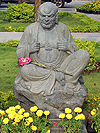
Jiw Pae Thong
(จิวแป๊ะทง)
Thai name for a figure with supernatural powers in the Chinese martial
arts story 'The Legend of the Condor Heroes', set in the Song Dynasty
(960-1279) and in Thai known as the 'Jade Dragon' (Mangkon Yok). It was
written by the novelist Jin Yong (金庸), who in Thai is called Kim Yong (กิมย้ง)
and in the West known as Louis Cha. Jiw Pae Thong is the younger
disciple brother of Wang Chong Yang of the Quanzhen Sect and although
he was one of the oldest characters in the novel, he still behaved in a
childish and mischievous manner like an immature toddler, thus earning
him his nickname Lao Wan Tong (老頑童), meaning the 'Old Imp' or 'Old
Urchin'. Despite their large difference in age, Zhou Bo Tong became
sworn brothers with Guo Jing and even taught him martial arts. He was by
far the most powerful martial artist alive after the death of Wang Chong
Yang. In Chinese Jiw Pae Thong is called Zhou Bo Tong.

ji xiang shou (吉祥兽)
Chinese. 'Lucky, auspicious quadrupeds' or 'lucky, propitious beasts'. A
name for Chinese Imperial roof decoration.


joss
Chinese Pidgin English. Term that refers to a Chinese 'idol' or 'deity'.
It is derived from the Javanese word dejos which itself comes from the
Portuguese word deus, meaning 'god'. Colloquially it came to mean
'luck'.

joss paper
See
gong de.

joss stick
Name for a kind of cored incense stick, a small wooden stick coated with
a thick layer of incense that burns away together with its core. Joss
sticks are burned in a special vessel called a kratahng toob in Thai,
but are usually discarded before being burned up completely. If not,
they are sometimes left and piled up on top of each other to form a
tower of sticks. Before burning joss sticks the person offering them
will first perform an athitahn, a quick prayer to ask for a blessing
whilst bringing the hands together above the head.


Journey to the West
See
Xiyouji.
 |